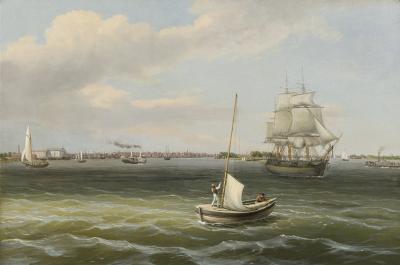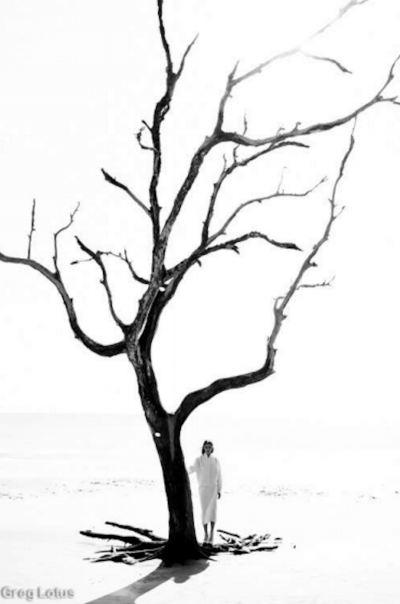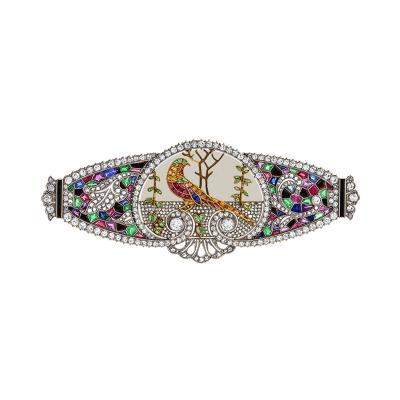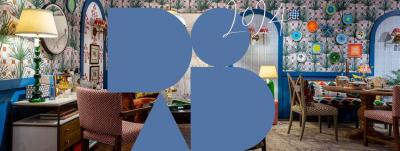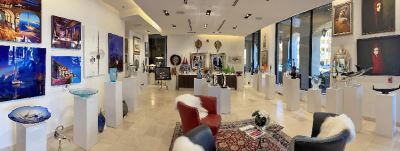The Worlds of Frederic Edwin Church
When, in 1855, Frederic Edwin Church began to exhibit his paintings of the South American landscape, based on his first voyage there two years earlier, he was quickly recognized as America’s greatest landscape painter, heir to that identification achieved by his teacher, Thomas Cole. Church’s reputation was enhanced when several of his works achieved critical recognition in London and the approval of John Ruskin, who admired Church’s great 1857 canvas, Niagara (Fig. 1). Church retained his supremacy in American landscape painting until he settled in 1872 into Olana, his ornate home outside of Hudson, New York, on which construction had begun in 1870. For the first few following years, Church continued to produce masterworks, but by the late 1870s, his few major pictures, such as El Rio de Luz (Fig. 2) distinctly suggest a composite memory image, as do a series of smaller paintings of the 1880s. His last significant picture, The Icebergs (Fig. 3), is a small, somber reminiscence of his great The Icebergs (Fig. 4) painted three decades earlier. Church’s retreat from the country’s art scene corresponded to the public’s preference for the French-derived Barbizon aesthetic of more generalized and poetic landscapes over the carefully defined, expansive interpretation that identified the Hudson River School, of which Church was one of the last, and surely the greatest master.
By the time Church died in 1900, he had been all but forgotten, and while The Metropolitan Museum of Art in New York mounted a small show of his paintings less than two months after his death, Church’s great pictures were to go unappreciated for many decades. Church’s reputation was revived in the 1960s, first by the general appreciation of mid-nineteenth century American painting that resulted from the formation and publication of the M. and M. Karolik collection of American paintings by the Museum of Fine Arts, Boston, and, more specifically, through the efforts of the late art historian David C. Huntington, who completed his dissertation on Church at Yale University in 1966 and subsequently became instrumental in the renovation of Olana, now a center for Church study and scholarship.1 At that time, Church was esteemed primarily for Niagara and his South American landscapes of the later 1850s and early ‘60s. More recently, recognition has been awarded to the North American landscapes, both those painted immediately following his study with Cole, such as New England Landscape with Ruined Chimney (Fig. 5), painted in 1846, which repeats his teacher’s concern for the passage of time and even adopts the oval format of a number of Cole’s domestic scenes of the 1840s, and more mature works of the early 1850s.
Church’s early American pictures partake of the nationalism that was rampant in the mid-nineteenth century, as evident among the landscape painters—Church included—who later became known as the “Hudson River School” (originally a term of disparagement coined when the works had gone out of favor). In the late 1840s and the early ‘50s, this Connecticut-born painter kept very much to New England, creating an amalgam of his visual experiences on canvases that reflect the optimistic belief in the harmony of man with nature in pre-Civil War America. By 1852, however, Church was determined to travel to South America, inspired by the writings of the scientist, naturalist, and travel writer Alexander von Humboldt, who challenged landscape painters to depict the incredible variety of scenic beauty that he had discovered in his travels there between 1794 and 1799.
This became Church’s mandate. Though not the first American artist to travel to South America—the Boston portraitist John Greenwood had gone to Surinam in 1752, and in 1845, New York landscape painter Jacob Ward traveled extensively through the region2 — Church’s excursion there can be seen as a further extolling of the romantic ideal of a pastoral New World, this one even less contaminated by European “civilization” than his own country. Church and his friend Cyrus Field left New York in April 1853 and traveled to Colombia, arriving at the mouth the Magdalena River. His letters home address the interesting nature of the villages through which he passed and the natural scenery that he was sketching, and upon which he drew for later pictures such as the several versions of his View on the Magdalena River (Fig. 6), in which he introduces the single palm tree, his most consistent trope in his South American landscapes.
Church and Field next visited Bogota, but their goal was Quito, Ecuador, which they reached on August 30, 1853. The high volcanic Andean peaks to the north and south of the capital became the basis for Church’s most celebrated South American landscapes. Cotopaxi, the mountain singled out by Humboldt as the highest, most beautiful, and also most dangerous, particularly figured in Church’s repertory when, back in New York, he began developing his South American sketches into finished paintings in 1855. In Cotopaxi (Fig. 7), the volcano, still active but benign, towers over the tropical landscape. In these paintings Church presents a “new” New World, one which stretches from the tropics to snow-capped peaks, nature in harmony with itself and with the figures and occasional buildings, as well at times of religious identification: wayside shrines and cross-shaped grave markers.
Church made a second visit to South America in 1857, this time only to Ecuador, accompanied by his fellow landscape painter, and sometime emulator, Louis Remy Mignot. On this trip, Church concentrated especially on oil studies of Chimborazo, which he later worked up in his studio in the new Tenth Street Studio Building in New York. Church was one of its first tenants, and it was in the large gallery there that his most celebrated South American masterwork, The Heart of the Andes (Fig. 8) was viewed by an ecstatic public.
South America ceased to be featured in Church’s oeuvre for the next few years, returning in the artist’s explosive Cotopaxi (Fig. 9) related to the smaller oil version, Eruption of Cotopaxi (Fig. 10). This later view of Cotopaxi reverses the harmonious natural interplay of his 1850s versions. Not surprisingly, this richly lit and high-colored yet barren landscape of opposing natural forces has been interpreted as reflective of the turmoil of the Civil War at home.
Church made one more artistically significant trip to Latin, if not South, America, visiting Jamaica in 1865 while recovering from the death of four of his children, two of whom had died in March of that year. The trip resulted in his vast canvas The Vale of St. Thomas, Jamaica (Fig. 11), a jungle scene in which a violent rain storm at the left seems to clear the landscape to lay out its beauty and infinite expanse. In subsequent years, as Church was drawn more to the Old World, South America functioned, not as a source of discovery and inspiration, but of nostalgia, such as in his Tropical Scenery (Fig. 12), painted in 1873, many years after his visits to South America, and lacking either specificity of form or geological identification. Humanity has greater presence here, too, than in his earlier tropical scenes, not only in the prominent foreground figure, but in the small city set on a distant plateau. A decade later, Church began almost annual visits to Mexico, but a serious arthritic condition and general ill health yielded only some oil sketches.
In the late 1850s, Church’s exploration of New World territories had also taken him to Newfoundland and Labrador in the frozen north, areas that had drawn explorers seeking the Northwest Passage from the Atlantic to the Pacific. Sir John Franklin’s ill-fated explorations of 1847 brought the region to public—and artistic—attention. In mid-1859, in the company of Louis Legrand Noble, Church traveled from Boston to Halifax and Sydney in Nova Scotia, and on to St. John’s in Newfoundland, and then still further north, to the southeastern tip of Labrador.3 Church painted multiple studies of icebergs on this voyage, culminating in his immense masterwork, The Icebergs (Fig. 4). Both paintings, devoid of life except for the remains of wrecked vessels in the foreground, relics of a lost expedition, presented to the public a world previously unseen and a contrasting pendant to the tropical glories which had so firmly established his fame in the mid-fifties.4 Church had spanned, south to north, the New World.
After the Civil War, Church looked to the Old World both for philosophic and artistic motivation, and it is difficult not to believe that he had lost faith in the glory and promise of the New World. Now he sought out monuments of past civilizations, replacing the natural wonders of the New World. In the late autumn of 1867, he set out for the Near East. He and his party settled in Beirut, from where Church explored the entire region, creating studies for two of his masterworks to be completed back in Olana: Jerusalem from The Mount of Olives (1870; Nelson-Atkins Museum of Art, Kansas City, Missouri) and El Khasné, Petra (Fig. 13). After an uninspiring summer in the Bavarian Alps, Church was in Athens in 1869. He wrote of “the wonderful ruins of the Acropolis,” and the revelation of the Parthenon, which he described as “certainly the culmination of the genius of man in architecture.”5 His studies made at the time would lead to his great canvas The Parthenon painted at Olana.
Back in the United States at the end of June 1869, Church’s attention was directed toward the construction of his fabled home, Olana, and his traveling days were essentially over. He continued to produce paintings based upon his earlier journeys, some South American views and more Near Eastern ones, though, perhaps due in part to his increasing arthritic condition, these have none of the crystalline quality of his earlier work and often appear to be composite memory images. Church’s last great Near Eastern canvas, The Aegean Sea (Fig. 14), is a composite view based on his experiences in the Holy Land, Lebanon, Syria, Greece, and Turkey, and bathed in Turneresque light, a tribute to the artist whose work he had become familiar with in London in 1869. In 1877, Church also created his last great South American image, El Rio de Luz (Fig. 2), again more a memory image of past experiences. The two pictures neatly encapsulate the Old and the New Worlds of Church’s pictorial and ideological anatomy.
Frederic Edwin Church: Romantic Landscapes and Seascapes will be on view at Adelson Galleries in New York from January 18 through March 1, 2008.
-----
William H. Gerdts is professor emeritus of art history at the Graduate School of the City University of New York.
2. For American artists in Latin America (including South and Central America and Mexico), see Katherine Emma Manthorne, Tropic Renaissance: North American Artists Exploring Latin America, 1839-1879 (Washington and London: Smithsonian Institution Press, 1989).
3. Louis Legrand Noble wrote about his experiences in After Icebergs with a Painter (New York: D. Appleton and Company, 1861).
4. The Icebergs has been the subject of two studies: Gerald L. Carr, Frederic Edwin Church: The Icebergs (Dallas: Dallas Museum of Art, 1980), and Eleanor Jones Harvey, The Voyage of the Icebergs: Frederic Church's Arctic Masterpiece (Dallas: Dallas Museum of Art, 2002).
5. Church to William H. Osborn, April 14, 1869. Transcript in Olana State Historic Site.





























